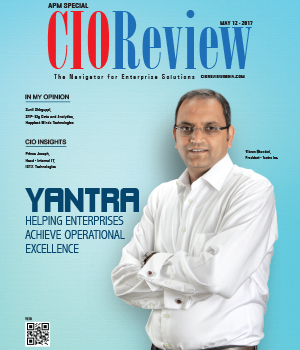
Predictable Delivery through Actionable Insights
Sridhar Krishnamurthy, Vice President – AppsNext Services, Brillio | Tuesday, 23 May 2017, 13:03 IST
 Our inherent curiosity often puts us at the crossroads of the desire to know what lies ahead and what could happen, and the fear of failure and uncertainty of the future. How- ever, it is those who venture into the dark, as far as business is concerned, who have come into the light. Predicting the future has become a business need for every enterprise. It is not on the sidelines anymore. Businesses are using Advanced Analytics to make key business decisions. CIOs also have a need to leverage advanced analytics capability in the core engineering practices to drive predictable delivery.
Our inherent curiosity often puts us at the crossroads of the desire to know what lies ahead and what could happen, and the fear of failure and uncertainty of the future. How- ever, it is those who venture into the dark, as far as business is concerned, who have come into the light. Predicting the future has become a business need for every enterprise. It is not on the sidelines anymore. Businesses are using Advanced Analytics to make key business decisions. CIOs also have a need to leverage advanced analytics capability in the core engineering practices to drive predictable delivery.
There are some fundamental questions that often arise in business that are seldom answered comprehensively such that they sum up the present while predicting the future, questions such as ‘are my projects on track, how predictable is my delivery date, what kind of visibility do I have on quality of deliverable or what are the bottlenecks likely to impact project delivery’. Traditionally, project managers have tried to answer these questions based on their own assessment, thereby making their responses very subjective. The accuracy of assessment is thus heavily dependent on the experience and skills of the project manager and team. Though there have been multiple models and methods developed (Six Sigma, EVM, Prediction models), none of them have addressed predictable delivery in a pervasive and comprehensive manner.
While these issues have plagued the business world, what has been going in on the IT front which can enable decision makers? For one, DevOps adoption has grown significantly and has become the mainstream and IT leaders continue to adopt Agile methodologies in a fast pace to deliver projects. Gartner states, “DevOps ecosystem market will grow globally at a robust CAGR 16% between 2017 and 2022, reaching $10 billion by 2021”. The way IT teams are planning and delivering projects is clearly shifting from process-centric project governance to engineering-focused governance. The shift is logical as core engineering activities have a huge influence on predicting the quality and delivery of the project.
Organizations have invested in DevOps tools across the application lifecycle (delivery pipeline) from Requirements to Release. There are on average 10-15 tools in a project that are used to automate various operational and repetitive tasks. All these tools right from ALM tools, code analyzers, test automation frameworks, build orchestration tools, deployment tools generate lots of data especially with long running projects / programs. Data generated by these tools are accurate and reliable for project governance and brings development and operations team together.
There is a huge opportunity to leverage and maximize the value of DevOps investments and feedback the tools provide. To improve predictability of delivery, an integrated process and engineering insights framework is required that addresses the following key elements:
- Holistic View of the Delivery Pipeline: - Integrate various data silos of the delivery pipeline encompassing en- tire application development lifecycle and associated data holistically to generate correlated insights of the project.
- Focus on Engineering Metrics: - The derived engineering insights empower the engineering teams to take decisions real-time that directly impacts project success, reduces rework, and avoids failures. Some of the key engineering insights are:
· Rule based RAG status prediction of the project through underlying engineering quality and project metrics
· Prediction of sprints required to complete PBI (Product Backlog Items) through regression models
· Early warning signals to predict code quality deterioration facilitating preventive actions
· Failed predictions of builds and releases to alert preventive actions
· Heat maps to help teams identify where failure points are to take action that reduces re-work and improve efficiency
· Applying regression and supervised learning techniques to identify milestone risks
- Apply Advanced Analytics: - Over a period, the data grows and provides a lot of historical context. Using the right statistical modelling technique and machine learning algorithms, one can generate real-time predictions and forecasts.
- Call for Action: - Just having various metrics is not enough, it’s important to provide interpretation of the correlated insights generated and prompt the project teams to act swiftly. This helps build correlations, success/failure patterns to take corrective actions at appropriate time, thereby, ensuring predictable delivery.
- Single View of Truth: - Create a unified project cockpit that provides simple and objective view of the project or portfolio with the right level of information for all stakeholders, right from the CIO to a Developer. This helps providing the visibility and transparency of the project consistent across the board and avoids conflicts and most importantly drives the entire organization to- wards coordinated and focussed action.
Organizations should not and cannot afford to rely on subjective governance to track the project progress and outcomes. Decisions such as those on delivery need to be based on real-time actionable insights which are generated from the data, the tools in the delivery pipe- line provide. And most importantly, the engineering teams should be empowered to act based on the insights. The integrated delivery pipeline, insights platform, and actions taken, enables predictable delivery, learning and helps foster a continuous improvement and agile culture within the team.
CIO Viewpoint
Focus of Application Management Solution...
By Martin Ingram, SVP & CIO, Arise Virtual Solutions Inc.
Need of the Hour: Customer Centric Build-Up of...
By Warren Neuburger, CIO & EVP Global Operations & Customer Care, PGi
Sustaining Performance and User Experience...
By Amit Pal Singh, Head - IT Transformation, Gionee India
CXO Insights
Modernizing a Company's Digital Core is Vital...
By Randy Meyer, VP & General Manager, Hewlett Packard Enterprise
5 Key Take a ways for Successful ALM...







